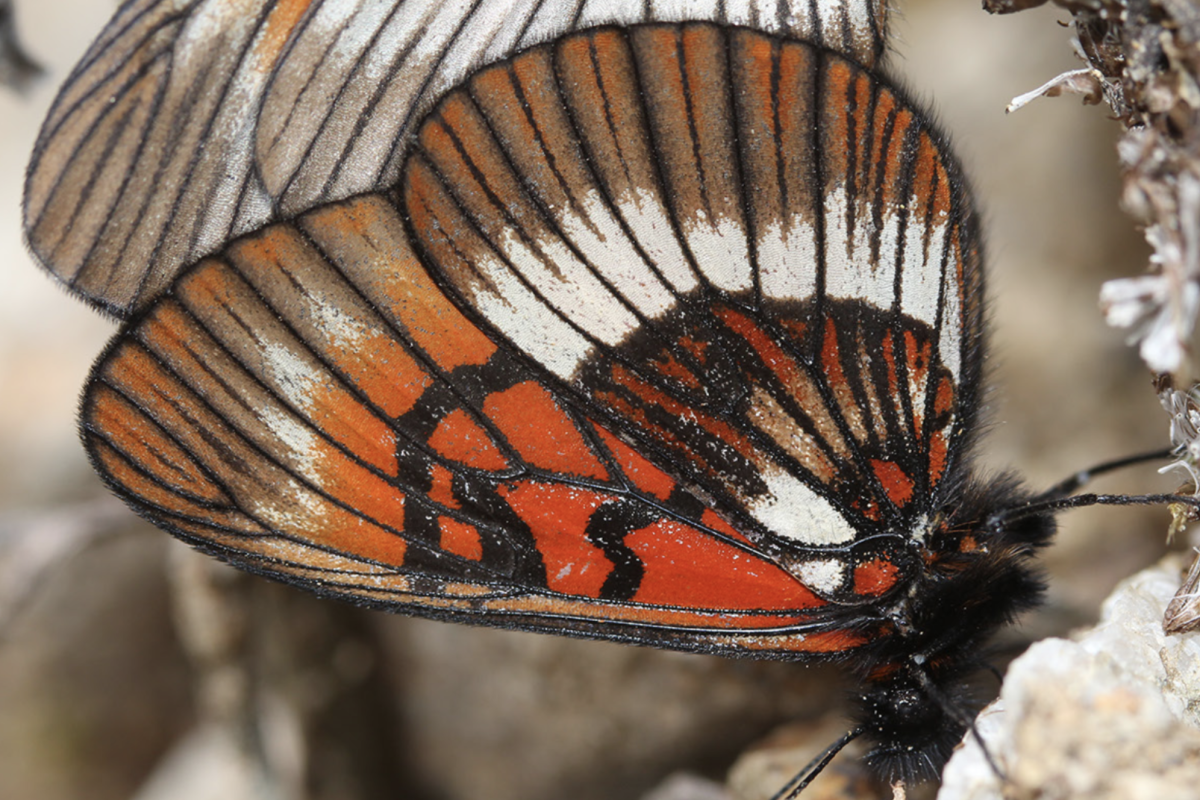A colorful new butterfly species that lives high up in the cloud forests of the Andes Mountains has been identified by scientists.
Researchers have given the species the scientific name Actinote pyrrhosticta, which can be translated as "stained with fire"—a reference to the reddish and orange coloration that is characteristic of the insect.
A. pyrrhosticta belongs to the genus (group of species) known as Actinote. They are relatively large, colorful and slow-flying butterflies that are distributed across Central and South America. They are mainly found in forest habitats ranging from sea level to altitudes of more than 13,000 feet.
Although several Actinote species are common, some are very rare, and new ones continue to be described in the two main centers of diversity for the genus—the Atlantic Forest of Brazil and the Andes, the longest mountain range on Earth.

The uppermost forests of the Andes, in particular, contain several Actinote species that are poorly represented in most natural history collections. A number of distinctive populations are scattered throughout the extensive tropical regions of this mountain range.
Now, researchers have described the new Actinote species in a study published in the journal Tropical Lepidoptera Research. The species is among those of this genus that are considered to be very rare. It lives in cloud forests, which are generally located high up on mountains in the tropics.
These forests frequently experience heavy rainfall and are often shrouded in mist as moisture-laden air is deflected upward by the mountains. Hence the name.
Cloud forests are among the most biodiverse ecosystems on Earth, hosting an array of unique species that are specially adapted to the wet environment.
The latest study described the new species based on specimens collected by the authors and other researchers in Ecuador and Peru over several years.
Specimens of the butterfly were first collected in Ecuador in the late 1990s by a researcher, Artur Jasinski, who was not involved in the latest study.
"I believe Jasinski probably recognized that it was a new 'taxon'—meaning a new species or subspecies—but because its relatives are also rare and show a lot of geographic variation, it wasn't clear whether it was a distinct species, or a geographic race of another species," Keith Willmott, an author of the latest study with the Florida Museum of Natural History, told Newsweek.
"And, because there were only two known specimens without very precise locality data, it was better to wait to gather more information to support its description."
Subsequently, Willmott and the other authors of the new study visited the same area before finally observing Actinote pyrrhosticta in 2014 at an altitude of around 10,000 feet on the western slopes of the Andes.
"This particular group of butterflies has waited a long time to be formally described and named—some specimens have been sitting in collections for decades. Mostly this is because these are butterflies that are very poorly represented in most natural history museums, and it has taken a while to put together sufficient information to support their descriptions," Willmott said.
"In the case of the new species, Actinote pyrrhosticta, we first visited the locality where this butterfly occurs in Ecuador in 1997, but didn't see it, and neither did we find it during subsequent visits in 2010 and 2013—we probably drove through the small patch of forest where it occurs at the wrong time of day, or while it was cloudy, or maybe there just were no adults flying during those visits," he said.
But on June 12, 2014, the butterflies were common around a small stream in the forest, flying down from the canopy, and after collecting specimens, the team had enough information to move ahead with the description.
"It's taken another nine years to achieve that in part because of the need to gather information for related species and populations, to be able to publish a more complete study of the group. So, it's very satisfying to finally get this paper published after so long," Willmott said.
During their fieldwork, the researchers observed several individuals, including representatives of both sexes. They were even able to observe males and females in the act of mating.
In the study, the researchers also describe eight new subspecies of Actinote pyrrhosticta, which are distributed across the high Andes of Colombia, Ecuador and Peru.
These subspecies have been named Actinote pyrrhosticta quintecocha, Actinote pyrrhosticta apurimac, Actinote pyrrhosticta alfamayo, Actinote Eresia albesia, Actinote estaresia canyaris, Actinote hilaris rainbow, Actinote hilaris sourakovi and Actinote trinacria alegria.
"I think that these new butterfly species and subspecies exemplify the difficulties in gaining a clear understanding of species richness and distribution in diverse tropical regions," Willmott said. "A. pyrrhosticta, for example, is only found in a narrow elevational band in the very uppermost forests at the edge of mountain grasslands in the Andes."
"Overall, the study highlights the continuing need to document the biodiversity of tropical mountain regions, where tiny remnant patches of forest may contain unique, unknown species even in groups as conspicuous and well-studied as butterflies."
Update 11/10/23 at 9:44 a.m. ET: This article was updated with additional information from Keith Willmott.
Uncommon Knowledge
Newsweek is committed to challenging conventional wisdom and finding connections in the search for common ground.
Newsweek is committed to challenging conventional wisdom and finding connections in the search for common ground.
About the writer
Aristos is a Newsweek science reporter with the London, U.K., bureau. He reports on science and health topics, including; animal, ... Read more
To read how Newsweek uses AI as a newsroom tool, Click here.






